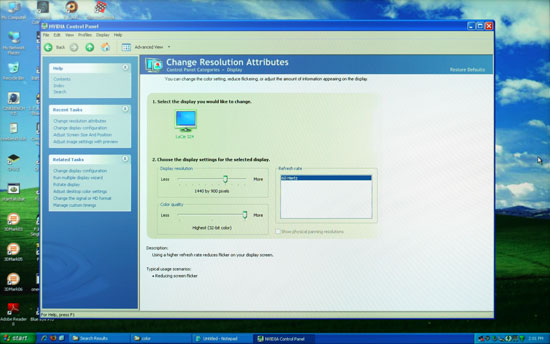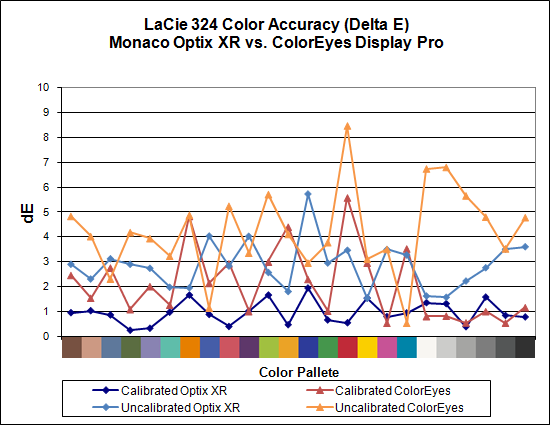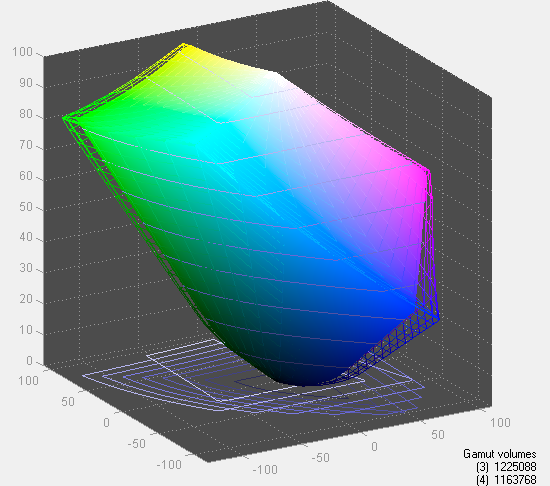LaCie 324 Evaluation
At first blush, the LaCie 324 OSD seems more limited than the options on other LCDs. There are only three main screens, one of which is for PIP. The other two screens are full of useful adjustments, however. LaCie also uses touch-sensitive buttons, and we periodically encountered difficulty with activating the "down" button (i.e. we would press it, move our finger around, etc. all to no avail; exiting the menu and returning would usually correct the problem). We would have preferred tactile feedback, but the overall result wasn't quite as finicky as the Samsung buttons, in part because the six buttons have white labels that are clearly visible.
LaCie provides six color presets, five color temperature settings, and five gamma levels. The last should be of particular interest to those involved with desktop publishing, where the ability to switch between 1.8 and 2.2 gamma can be useful. The 324 also has an "Over Speed" option that is supposed to improve pixel response times. Again, we didn't notice any serious issues with pixel response, but unfortunately the "over speed" mode does not address input lag.
| LaCie 324 Resolution and Input Notes | |||
| DVI | HDMI | VGA | |
| 800x600 | Yes | Wrong AR; Stretches horizontally to fill LCD | Yes |
| 1024x768 | Yes | Wrong AR; Stretches horizontally to fill LCD | Yes |
| 1152x864 | Yes | Wrong AR; Stretches horizontally to fill LCD | - |
| 1176x664 | Poor scaling artifacts | Underscanned 720P | - |
| 1280x720 | Poor scaling artifacts | Yes | Yes |
| 1280x768 | - | - | Sets 1280x800 and clips top and bottom |
| 1280x800 | Wrong AR (1280x960) | Wrong AR; Stretches horizontally to fill LCD | Yes |
| 1280x960 | Yes | Wrong AR; Stretches horizontally to fill LCD | Yes |
| 1280x1024 | Yes | Wrong AR; Stretches horizontally to fill LCD | Yes |
| 1400x1050 | - | Wrong AR; Stretches horizontally to fill LCD | - |
| 1440x900 | Yes | Wrong AR; Stretches horizontally to fill LCD | Yes |
| 1600x1200 | Yes | Wrong AR; Stretches horizontally to fill LCD | Yes |
| 1680x1050 | Always has top/bottom black borders | Wrong AR; Stretches horizontally to fill LCD | Yes |
| 1768x992 | - | Underscanned 1080P | - |
| 1920x1080 | Interference/Static Present; Always has top/bottom black borders | Yes | Clips output to 1680x1050 |
| 1920x1200 | Yes | - | Yes |
There are four scaling options: Real, Smart Zoom, Zoom, and Dx2D. "Real" is the same as what other LCD manufacturers call "1:1". "Smart Zoom" stretches whatever resolution you are running to fill the LCD while maintaining the correct aspect ratio, and "Zoom" fills the entire LCD. We're not at all sure what the "Dx2D" is supposed to do; sometimes it looks the same as "Smart Zoom" and other times it looks like "Real", though in a few cases using it instead of one of the other scaling options will result in fewer scaling artifacts.
For the inputs, HDMI only works properly with 720P/1080P resolutions and should be avoided for most other resolutions if possible; otherwise you get a horizontally stretched image with black borders on the top and bottom. VGA connections work properly except for a couple resolutions, while DVI has scaling errors on several resolutions, including the frequently used 1680x1050. It also seemed as though the VGA input showed more signal interference than on other LCDs, but the cable we were using may have been to blame.
 |
Scaling on the LaCie 324 looks good when it works properly, as seen here. Just do your best to avoid the problem resolutions/inputs listed in the chart above.


Considering this is a professional LCD, we were definitely interested in seeing what sort of color accuracy LaCie could achieve. If we had looked at the 324 before receiving some of the other monitors, the uncalibrated color accuracy would have been very impressive. As it stands, LaCie does well but professionals will still want to use calibration hardware and software. Color gamut is also good, coming in at 95%.
The question on our minds while reviewing the LaCie 324 is what exactly do users get for the extra ~50% price increase relative to the competition? We can say quite easily that we are not the target market, despite the fact that we do plenty of online publishing. For most users, 10-bit gamma correction and color lookup tables just aren't going to make that big of a difference. After all, Dell manages to achieve better color accuracy according to our measurements. However, the selection of gamma, temperature, and color options within the OSD will likely benefit certain users.
If you have a regular need to work at 1.6 gamma to 2.4 gamma, the LaCie may in fact be the better choice. The 10-bit gamma helps to provide better gradients without banding. Perhaps more important is the warranty that LaCie provides. A 3-year warranty isn't any better than what many of the other companies provide, but an advance replacement policy to minimize downtime is noteworthy. LaCie also sells a bundled package consisting of the 324 LCD with their blue eye pro software and colorimeter, and they state that the software is tuned for their hardware. Finally, LaCie is committed to using the same wide color gamut S-PVA panel on all 324 LCDs, so you won't find different versions with different panels. They test for color uniformity and only use panels that pass their testing, eliminating lower grade panels.
As a whole package, LaCie is clearly targeting professional users, from the LCD and warranty to their blue eye pro software and colorimeter. We did run some initial tests with blue eye pro, and one aspect that is definitely better than competing solutions is that the software and hardware worked under Vista 64-bit -- something we can't say of ColorEyes Display Pro or Optix XR Pro. There were some periodic pauses when we tried to use blue eye pro under 64-bit Vista, but it did successfully calibrate our test monitor.
Given the online price of $900 or more, we are more inclined to stick with one of the LCD alternatives. After all, $900 will get you pretty much any other 24" LCD plus appropriate calibration equipment -- sometimes with change left over. However, there's a reason LaCie is viewed as a professional solution and if that's your line of work, the extra cost should be easy to stomach as a long-term investment.
















89 Comments
View All Comments
feraltoad - Friday, May 2, 2008 - link
Do you think a subsequent Dell Revision will fix this or as you suggest are we seeing possible limitations in that panel technology?Currently some users are reporting a "red tint" on the left side of their monitors. Has anyone experienced this?
Owners of the Dell 2408 I would appreciate some opinions about this monitor, because I want to upgrade to a 24inch LCD (& get rid of a CRT on a second PC), but as I currently have a 21inch LCD (HP f2105) that I am mostly happy with I want to get something thing that will be a definite improvement. As Jarred states the Dell, sans any lemons, looks to be perfect except for the slight input lag, and that's the concensus I've seen among opinions on various sites. I don't think I could even notice but I would like to hear some people with experience with the 2408. I would value Anandtech readers' opinions more than reviews off Dell's site since we are probably more on the same page.
Gast - Friday, May 2, 2008 - link
http://forums.anandtech.com/messageview.aspx?catid...">http://forums.anandtech.com/messageview.aspx?catid...From this should come your dork binding monitor, which looks to be the DoubleSight DS-263N with the chance of a polarizer. I'm sad that the article neglected to even mention this great resource.
rcraig - Friday, May 2, 2008 - link
I, too, am waiting for a review of the DoubleSight DS-263N. I have read a lot about this monitor in another forum and it seems to be the one monitor to rule them all. Great colors for phtotgraphs, low lag for games, IPS for great viewing angles, and 26 inches for only $680! It only lacks the many input features some offer, but it does offer dual DVI, VGA, and 4 USB's.JarredWalton - Friday, May 2, 2008 - link
I've sent a couple email messages to DoubleSight, so far with no response. Same goes for a variety of other manufacturers. I'd love to go out and buy the LCDs I want to review, but that's not financially practical. :-(XtAzY - Friday, May 2, 2008 - link
I'm just skimming through the article, but does it mention anything about GHOSTING?JarredWalton - Friday, May 2, 2008 - link
You're talking about pixel response times. See page 12 and look at the images.musicman1352000 - Friday, May 2, 2008 - link
I have been waiting - desperately hoping and praying - that anandtech would review the dell 2408. It seems to be a stand out performer to me but I've been really put off buying it by the number of complaints of pink/red "tint", uneven brightness, colourful font halos, and bad input lag posted in forums. Reviews contradict each other and many people are waiting for a revision to solve the perceived problems like input lag (coming from an engineer, I am fully aware this particular problem can't be solved by a revision!). What I'd like to know is whether you noticed any of the problems I mentioned (not including the input lag which you obviously picked up on), and what revision of monitor you received (A00 or A01)? Also, Dell don't seem keen on telling users what versions of HDMI and displayport are used - do you know anything about this?JarredWalton - Friday, May 2, 2008 - link
I noticed no problems with the quality of the panel on the 2408WFP I received, with is revision A00. However, that doesn't mean some panels don't have problems. If overall quality is that important, LaCie seems to do a better job judging by their reputation (and price).I imagine part of the problem users have is that the default brightness on many monitors is way too high, and sometimes color settings need to be turned down as well. You can see that at 80-80-80 RGB with 50 on brightness and contrast, the Dell achieved exceptional color accuracy even without calibration. Is this just a cherry-picked sample? I certainly hope not!
I have no idea what version of DisplayPort the 2408 uses - and lacking any video cards with the feature I couldn't even test it right now. For HDMI, I would assume it's not 1.3, but I could be wrong. Probably v1.1 or maybe 1.2 - is there any easy way to tell? If someone can point me to a utility that will report the HDMI version, I'll be happy to test.
musicman1352000 - Friday, May 2, 2008 - link
Mmm okay - thank you for replying.One of the worst things about living in New Zealand is the increased cost of buying computer parts, and the reduced ranges available (see http://www.pricespy.co.nz/cat_5.html#g147)">http://www.pricespy.co.nz/cat_5.html#g147). The Dell costs $1199.00 NZD here (and the Lacie is unavailable). That's approximately $930 when translated to USD. As I understand it the cost is ~$700 in the US?
With regards to the HDMI/displayport versions: unfortunately I don't know of any way in which you could test the display to find out. Tektronix offers software for 1.3b compliance testing (trial: http://www2.tek.com/cmswpt/swdetails.lotr?ct=SW&am...">http://www2.tek.com/cmswpt/swdetails.lo...CDSA7160...
but I think this is more engineering oriented. Maybe someone else has a suggestion?
Thanks once again for your opinions :)
feelingshorter - Friday, May 2, 2008 - link
I hope anandtech reviews some of the cheaper monitors in the future also. The cheapest monitors reviewed, being the gateway/samsung at 450 is a steep price for some of us.Just to name the cheaper ones on newegg, SCEPTRE X24WG is at 300 (AR) and seems to be the poor man's 24, or the KDS K-24MDWB at 350 is also at a reasonable price. Plus wouldn't comparing the low end be a good idea to see if you can justify paying for a $1000 lacie (or 500+) gets you more?